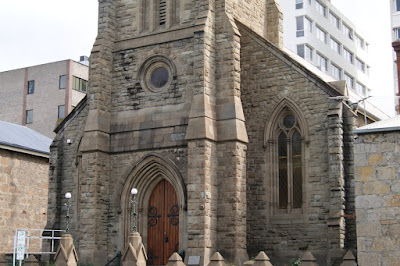300,000 Blog Post Views!
Accordingly, the land in Liverpool street was disposed of, and the site on which the new church stands was purchased. Matters having thus progressed, arrangements were made for commencing the church, and a design by Messrs, Tiffin and Davidson having been approved, and a contract for the building entered into with Mr. James Pretty, the First Stone was laid on the 31st July, 1856, by Henry Hopkins, Esq, on which occasion an exposition of the religious belief and principles of church government prevailing amongst the Congregational churches was delivered by the minister of the congregation, the Rev. G. Clarke.
The Church is in the style of early English architecture of the days of King John. The façade presents the distinguishing characteristics of the style, consisting of a tower and broach spire, (94 feet high in the clear) with an entrance by one deeply recessed doorway. This opens into a porch, whence springs a staircase turning right and left, giving access to the galleries, while entrance to the body of the building is obtained by means of side doors also leading out of the porch.
The church consists of a nave, two aisles, a chancel, and vestry. The roof is open timbered, consisting of hard wood boarded and slated, supported by nave piers formed of eight alternated clustered and octagonal columns ; the exterior is relieved by projecting buttresses. The chancel is lighted by a three-light-pointed window bordered with stained glass. The side lights are plain, pointed with splayed jambs. The pulpit, formed of cedar, handsomely carved, is placed at the junction of the nave and chancel, and instead of pews (those disfigurements to most modern places of worship) open benches also of cedar have been adopted, by which accommodation for upwards of 700 persons is obtained.
The church is built of freestone from the Risdon quarries, and the manner in which the work has been carried out was creditable to the contractor Mr. Pretty, and the architects Messrs. Tiffin & Davidson. Mr. Tiffin having left the colony the work has been superintended latterly by Mr. Davidson. The total cost, including purchase of site, the church architects' fees, the erection of the wall, iron railing in front, and gas fittings, &c has not exceeded £7000, and it is gratifying to state that at the time of the opening only £600 of this large sum remained unpaid.
It is also still more gratifying to announce that, owing to the munificence of those who on Sunday assembled within the walls of the sacred edifice; this debt was further reduced to the sum of £256. It is worthy of remark, that the church has been built and the outlay met solely from voluntary contributions raised chiefly by the congregation, but with the aid of the members of the denomination, as well as of other Christian bodies, including several members of the Church of England.
The church building had remained vacant for a number of years and was sold as recently as 2012 with a view to redevelopment.
Main Text & Information Source -
Historical Photos -















